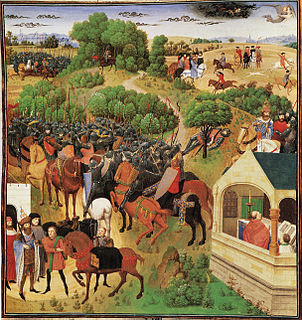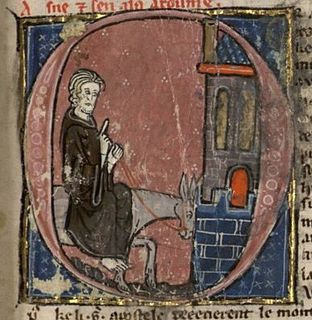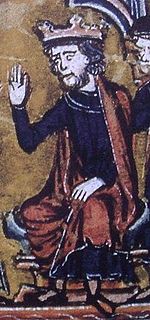
The Song of Roland is an epic poem based on the Battle of Roncevaux Pass in 778, during the reign of Charlemagne. It is the oldest surviving major work of French literature and exists in various manuscript versions, which testify to its enormous and enduring popularity in the 12th to 14th centuries.

Renaud de Montauban was a fictional hero and knight who was introduced to literature in a 12th-century Old French chanson de geste known as Les Quatre Fils Aymon. The four sons of Duke Aymon are Renaud, Richard, Alard, and Guiscard, and their cousin is the magician Maugris. Renaud possess a magical horse Bayard and the sword Froberge.
The Matter of France, also known as the Carolingian cycle, is a body of literature and legendary material associated with the history of France, in particular involving Charlemagne and his associates. The cycle springs from the Old French chansons de geste, and was later adapted into a variety of art forms, including Renaissance epics and operas. Together with the Matter of Britain, which concerned King Arthur, and the Matter of Rome, comprising material derived from and inspired by classical mythology, it was one of the great literary cycles that figured repeatedly in medieval literature.

The Chanson d'Antioche is a chanson de geste in 9000 lines of alexandrines in stanzas called laisses, now known in a version composed about 1180 for a courtly French audience and embedded in a quasi-historical cycle of epic poems inspired by the events of 1097–99, the climax of the First Crusade: the conquest of Antioch and of Jerusalem and the origins of the Crusader states. The Chanson was later reworked and incorporated in an extended Crusade cycle, of the 14th century, which was far more fabulous and embroidered, more distinctly romance than epic.

William of Gellone, the medieval William of Orange, was the second Duke of Toulouse from 790 until 811. In 804, he founded the abbey of Gellone. He was canonized a saint in 1066 by Pope Alexander II.
The 12th-century chanson de geste of Garin le Loherain is one of the fiercest and most sanguinary narratives left by the trouvères. This local cycle of Lorraine, which is completed by Hervis de Metz, Girbers de Metz, Ansis, fils de Girbert, and Von, appears to have a historical basis. Although the actions as recorded cannot be identified with specific historical events, the poems are valuable depictions of the savage feudal wars in the 11th and 12th centuries.
La Geste de Garin de Monglane is the second cycle of the three great cycles of chansons de geste created in the early days of the genre. It centres on Garin de Monglane.

Frisian participation in the Crusades is attested from the very beginning of the First Crusade, but their presence is only felt substantially during the Fifth Crusade. They participated in almost all the major Crusades and the Reconquista. The Frisians are almost always referred to collectively by contemporary chroniclers of the Crusades and few names of individual Frisian crusaders have come down to us. They generally composed a naval force in conjunction with other larger bodies of crusaders.
Esmoreit is a Middle Dutch drama. It is one of the four abele spelen that are contained in the Hulthemse handschrift and consists of 1018 lines in rhyme.
Gloriant is a Middle Dutch drama. It is one of the four abele spelen that are contained in the Hulthemse handschrift and consists of 1142 lines in rhyme.
Aymeri de Narbonne is a legendary hero of Old French chansons de geste and the Matter of France. In the legendary material, as elaborated and expanded in various medieval texts, Aymeri is a knight in the time of Charlemagne's wars with the Saracens after the Battle of Roncevaux Pass. He is son of Hernaut and the grandson of Garin de Monglane. He conquers the city of Narbonne, marries a princess named Hermengarde or Hermenjart, and fathers seven sons, the most famous being Guillaume d'Orange, the hero of several popular chansons de geste.
The Chanson de Guillaume or Chançun de Willame is a chanson de geste from the first half of the twelfth-century. The work is generally considered to have two distinct halves: the first tells of Guillaume of Orange, his nephew Vivien and the latter's young brother Gui and their various battles with Saracens at L'Archamp; in the second half of the poem, Guillaume is aided by Rainouard, a giant.
The Charroi de Nîmes, is an Old French chanson de geste from the first half of the twelfth-century, part of the cycle of chansons concerning Guillaume of Orange, generally referred to collectively as the Geste de Guillaume d'Orange.
Gormond et Isembart is an Old French chanson de geste from the second half of the eleventh or first half of the twelfth century. Along with The Song of Roland and the Chanson de Guillaume, it is one of the three chansons de geste whose composition incontestably dates from before 1150; it may be slightly younger than The Song of Roland and, according to one expert, may date from as early as 1068. The poem tells the story of a rebellious young French lord, Isembart, who allies himself with a Saracen king, Gormond, renounces his Christianity, and battles the French king. The poem is sometimes grouped with the Geste de Doon de Mayence or "rebellious vassal cycle" of chansons de geste.
Murgleys, or Murgleis is the sword of Ganelon, a traitorous French (Frankish) count and nemesis to the titular hero of the epic La chanson de Roland.
Aiquin, subtitled La conqueste de la Bretaigne par le roy Charlemaigne, is a medieval Old French chanson de geste about the rivalry between a Saracen king, Aiquin, and the Christian emperor Charlemagne. The French medievalist Joseph Bédier called it a "consolidation of history and legend in an imposing ensemble." It survives in one fifteenth-century manuscript, BnF fr. 2233, now in the Bibliothèque nationale de France. It is usually attributed to Garin Trosseboeuf, possibly a cleric of Dol, and was probably written in the late twelfth century. It is the oldest extant French text from Brittany.
Aiol and Mirabel is an Old French chanson de geste. Originating probably in the late twelfth century, the oldest copy in Old French dates from circa 1220. It was translated into Middle Dutch, Italian, and Spanish. The narrative recounts the adventures of the young knight Aiol who attempts to restore his father's fiefdom, and along the way marries a Saracen princess.
Edmond-René Labande (1908-1992) was a French archivist and historian.











